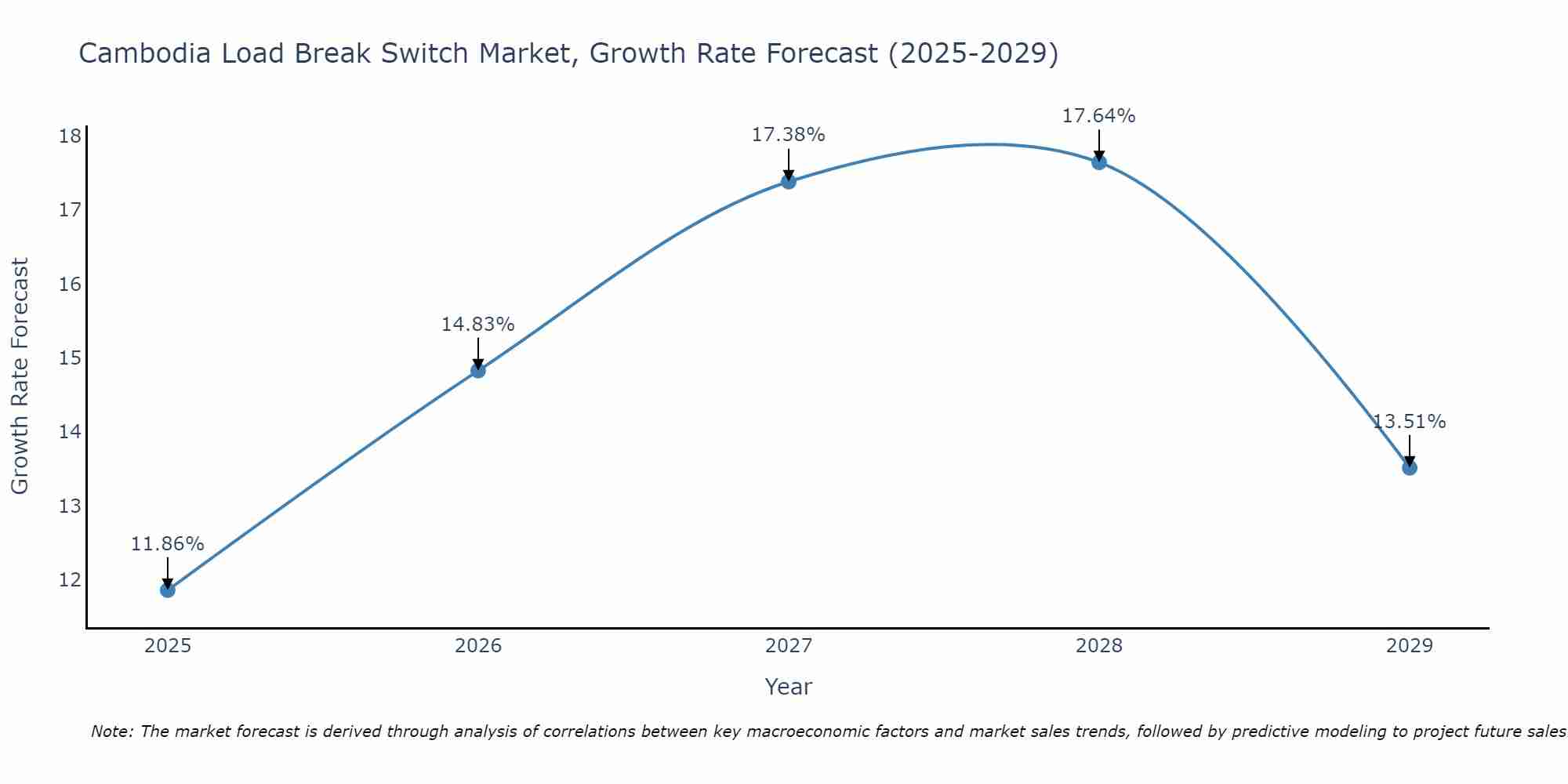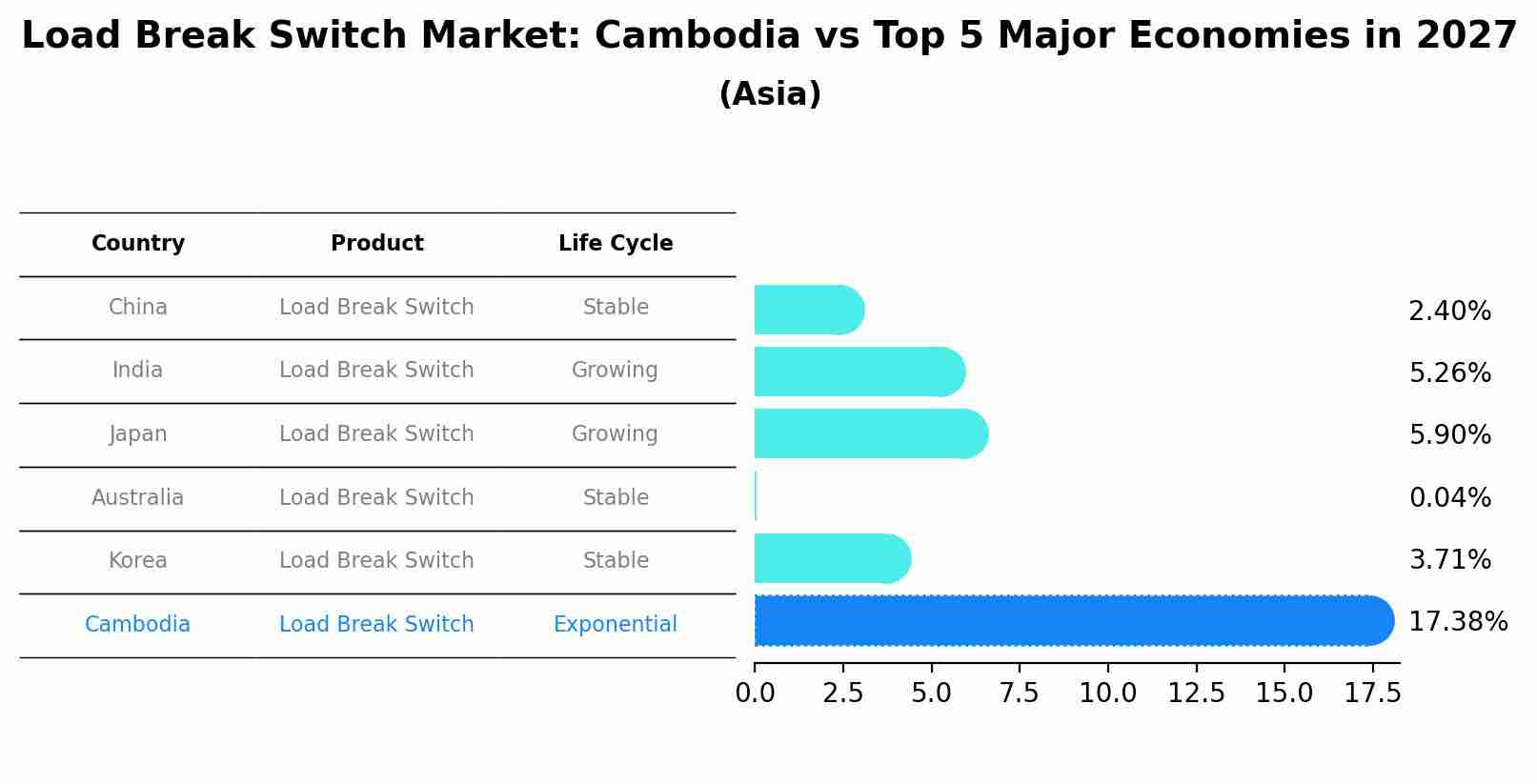Cambodia Load Break Switch Market (2025-2031) Outlook | Trends, Industry, Forecast, Value, Analysis, Size, Share, Revenue, Companies & Growth
| Product Code: ETC266613 | Publication Date: Aug 2022 | Updated Date: Aug 2025 | Product Type: Market Research Report | |
| Publisher: 6Wresearch | Author: Ravi Bhandari | No. of Pages: 75 | No. of Figures: 35 | No. of Tables: 20 |
Cambodia Load Break Switch Market Size Growth Rate
The Cambodia Load Break Switch Market is projected to witness mixed growth rate patterns during 2025 to 2029. Starting at 11.86% in 2025, the market peaks at 17.64% in 2028, and settles at 13.51% by 2029.

Load Break Switch Market: Cambodia vs Top 5 Major Economies in 2027 (Asia)
By 2027, the Load Break Switch market in Cambodia is anticipated to reach a growth rate of 17.38%, as part of an increasingly competitive Asia region, where China remains at the forefront, supported by India, Japan, Australia and South Korea, driving innovations and market adoption across sectors.

Cambodia Load Break Switch Market Overview
Load break switches are electrical switches used for making, carrying, and breaking currents in power distribution networks and industrial applications in Cambodia. The market for load break switches is driven by factors such as urbanization, infrastructure development, and demand for reliable and safe electrical distribution systems, supporting the country`s economic growth and industrialization.
Drivers of the market
The Cambodia load break switch market is witnessing steady growth driven by the expanding electrical infrastructure, urbanization, and industrialization in the country. Load break switches, also known as disconnect switches, play a crucial role in electrical distribution networks for isolating and disconnecting circuits under load conditions. With the government`s investments in power generation, transmission, and distribution infrastructure, the demand for load break switches is increasing in Cambodia utility and industrial sectors. Moreover, the growing emphasis on renewable energy integration, smart grid development, and grid modernization initiatives is further stimulating market growth in the country.
Challenges of the market
Challenges in the load break switch market include technical complexities in installation, maintenance, and reliability issues, especially in harsh environmental conditions.
Government Policy of the market
The Cambodian government recognizes the importance of reliable electrical infrastructure for economic development and public safety. Policies are implemented to regulate the production, import, and installation of load break switches, essential components of electrical distribution systems. Standards are enforced to ensure product quality, performance, and safety, as well as to promote interoperability and compatibility with existing infrastructure.
Key Highlights of the Report:
- Cambodia Load Break Switch Market Outlook
- Market Size of Cambodia Load Break Switch Market, 2024
- Forecast of Cambodia Load Break Switch Market, 2031
- Historical Data and Forecast of Cambodia Load Break Switch Revenues & Volume for the Period 2021-2031
- Cambodia Load Break Switch Market Trend Evolution
- Cambodia Load Break Switch Market Drivers and Challenges
- Cambodia Load Break Switch Price Trends
- Cambodia Load Break Switch Porter's Five Forces
- Cambodia Load Break Switch Industry Life Cycle
- Historical Data and Forecast of Cambodia Load Break Switch Market Revenues & Volume By Type for the Period 2021-2031
- Historical Data and Forecast of Cambodia Load Break Switch Market Revenues & Volume By Gas-Insulated for the Period 2021-2031
- Historical Data and Forecast of Cambodia Load Break Switch Market Revenues & Volume By Air-Insulated for the Period 2021-2031
- Historical Data and Forecast of Cambodia Load Break Switch Market Revenues & Volume By Others for the Period 2021-2031
- Historical Data and Forecast of Cambodia Load Break Switch Market Revenues & Volume By Deployment for the Period 2021-2031
- Historical Data and Forecast of Cambodia Load Break Switch Market Revenues & Volume By Outdoor for the Period 2021-2031
- Historical Data and Forecast of Cambodia Load Break Switch Market Revenues & Volume By Indoor for the Period 2021-2031
- Historical Data and Forecast of Cambodia Load Break Switch Market Revenues & Volume By End-User for the Period 2021-2031
- Historical Data and Forecast of Cambodia Load Break Switch Market Revenues & Volume By Utilities for the Period 2021-2031
- Historical Data and Forecast of Cambodia Load Break Switch Market Revenues & Volume By Commercial for the Period 2021-2031
- Historical Data and Forecast of Cambodia Load Break Switch Market Revenues & Volume By Industrial for the Period 2021-2031
- Cambodia Load Break Switch Import Export Trade Statistics
- Market Opportunity Assessment By Type
- Market Opportunity Assessment By Deployment
- Market Opportunity Assessment By End-User
- Cambodia Load Break Switch Top Companies Market Share
- Cambodia Load Break Switch Competitive Benchmarking By Technical and Operational Parameters
- Cambodia Load Break Switch Company Profiles
- Cambodia Load Break Switch Key Strategic Recommendations
Frequently Asked Questions About the Market Study (FAQs):
1 Executive Summary |
2 Introduction |
2.1 Key Highlights of the Report |
2.2 Report Description |
2.3 Market Scope & Segmentation |
2.4 Research Methodology |
2.5 Assumptions |
3 Cambodia Load Break Switch Market Overview |
3.1 Cambodia Country Macro Economic Indicators |
3.2 Cambodia Load Break Switch Market Revenues & Volume, 2021 & 2031F |
3.3 Cambodia Load Break Switch Market - Industry Life Cycle |
3.4 Cambodia Load Break Switch Market - Porter's Five Forces |
3.5 Cambodia Load Break Switch Market Revenues & Volume Share, By Type, 2021 & 2031F |
3.6 Cambodia Load Break Switch Market Revenues & Volume Share, By Deployment, 2021 & 2031F |
3.7 Cambodia Load Break Switch Market Revenues & Volume Share, By End-User, 2021 & 2031F |
4 Cambodia Load Break Switch Market Dynamics |
4.1 Impact Analysis |
4.2 Market Drivers |
4.2.1 Increasing investments in infrastructure development projects in Cambodia |
4.2.2 Growing demand for reliable and efficient electricity distribution systems |
4.2.3 Government initiatives to enhance the country's power transmission and distribution networks |
4.3 Market Restraints |
4.3.1 Limited technical expertise and skilled labor in the installation and maintenance of load break switches |
4.3.2 Volatility in raw material prices impacting manufacturing costs |
4.3.3 Regulatory challenges and delays in project approvals |
5 Cambodia Load Break Switch Market Trends |
6 Cambodia Load Break Switch Market, By Types |
6.1 Cambodia Load Break Switch Market, By Type |
6.1.1 Overview and Analysis |
6.1.2 Cambodia Load Break Switch Market Revenues & Volume, By Type, 2021-2031F |
6.1.3 Cambodia Load Break Switch Market Revenues & Volume, By Gas-Insulated, 2021-2031F |
6.1.4 Cambodia Load Break Switch Market Revenues & Volume, By Air-Insulated, 2021-2031F |
6.1.5 Cambodia Load Break Switch Market Revenues & Volume, By Others, 2021-2031F |
6.2 Cambodia Load Break Switch Market, By Deployment |
6.2.1 Overview and Analysis |
6.2.2 Cambodia Load Break Switch Market Revenues & Volume, By Outdoor, 2021-2031F |
6.2.3 Cambodia Load Break Switch Market Revenues & Volume, By Indoor, 2021-2031F |
6.3 Cambodia Load Break Switch Market, By End-User |
6.3.1 Overview and Analysis |
6.3.2 Cambodia Load Break Switch Market Revenues & Volume, By Utilities, 2021-2031F |
6.3.3 Cambodia Load Break Switch Market Revenues & Volume, By Commercial, 2021-2031F |
6.3.4 Cambodia Load Break Switch Market Revenues & Volume, By Industrial, 2021-2031F |
7 Cambodia Load Break Switch Market Import-Export Trade Statistics |
7.1 Cambodia Load Break Switch Market Export to Major Countries |
7.2 Cambodia Load Break Switch Market Imports from Major Countries |
8 Cambodia Load Break Switch Market Key Performance Indicators |
8.1 Percentage increase in the number of infrastructure projects in Cambodia |
8.2 Average downtime of electricity distribution systems |
8.3 Adoption rate of advanced load break switch technologies |
8.4 Percentage growth in renewable energy projects connected to load break switches |
8.5 Number of new partnerships or collaborations in the load break switch market |
9 Cambodia Load Break Switch Market - Opportunity Assessment |
9.1 Cambodia Load Break Switch Market Opportunity Assessment, By Type, 2021 & 2031F |
9.2 Cambodia Load Break Switch Market Opportunity Assessment, By Deployment, 2021 & 2031F |
9.3 Cambodia Load Break Switch Market Opportunity Assessment, By End-User, 2021 & 2031F |
10 Cambodia Load Break Switch Market - Competitive Landscape |
10.1 Cambodia Load Break Switch Market Revenue Share, By Companies, 2024 |
10.2 Cambodia Load Break Switch Market Competitive Benchmarking, By Operating and Technical Parameters |
11 Company Profiles |
12 Recommendations |
13 Disclaimer |
- Single User License$ 1,995
- Department License$ 2,400
- Site License$ 3,120
- Global License$ 3,795
Search
Thought Leadership and Analyst Meet
Our Clients
Related Reports
- Vietnam System Integrator Market (2025-2031) | Size, Companies, Analysis, Industry, Value, Forecast, Growth, Trends, Revenue & Share
- ASEAN and Thailand Brain Health Supplements Market (2025-2031) | Strategy, Consumer Insights, Analysis, Investment Trends, Opportunities, Growth, Size, Share, Industry, Revenue, Segments, Value, Segmentation, Supply, Forecast, Restraints, Outlook, Competition, Drivers, Trends, Demand, Pricing Analysis, Competitive, Strategic Insights, Companies, Challenges
- ASEAN Bearings Market (2025-2031) | Strategy, Consumer Insights, Analysis, Investment Trends, Opportunities, Growth, Size, Share, Industry, Revenue, Segments, Value, Segmentation, Supply, Forecast, Restraints, Outlook, Competition, Drivers, Trends, Demand, Pricing Analysis, Competitive, Strategic Insights, Companies, Challenges
- Europe Flooring Market (2025-2031) | Outlook, Share, Industry, Trends, Forecast, Companies, Revenue, Size, Analysis, Growth & Value
- Saudi Arabia Manlift Market (2025-2031) | Outlook, Size, Growth, Trends, Companies, Industry, Revenue, Value, Share, Forecast & Analysis
- Uganda Excavator, Crane, and Wheel Loaders Market (2025-2031) | Strategy, Consumer Insights, Analysis, Investment Trends, Opportunities, Growth, Size, Share, Industry, Revenue, Segments, Value, Segmentation, Supply, Forecast, Restraints, Outlook, Competition, Drivers, Trends, Demand, Pricing Analysis, Competitive, Strategic Insights, Companies, Challenges
- Rwanda Excavator, Crane, and Wheel Loaders Market (2025-2031) | Strategy, Consumer Insights, Analysis, Investment Trends, Opportunities, Growth, Size, Share, Industry, Revenue, Segments, Value, Segmentation, Supply, Forecast, Restraints, Outlook, Competition, Drivers, Trends, Demand, Pricing Analysis, Competitive, Strategic Insights, Companies, Challenges
- Kenya Excavator, Crane, and Wheel Loaders Market (2025-2031) | Strategy, Consumer Insights, Analysis, Investment Trends, Opportunities, Growth, Size, Share, Industry, Revenue, Segments, Value, Segmentation, Supply, Forecast, Restraints, Outlook, Competition, Drivers, Trends, Demand, Pricing Analysis, Competitive, Strategic Insights, Companies, Challenges
- Angola Excavator, Crane, and Wheel Loaders Market (2025-2031) | Strategy, Consumer Insights, Analysis, Investment Trends, Opportunities, Growth, Size, Share, Industry, Revenue, Segments, Value, Segmentation, Supply, Forecast, Restraints, Outlook, Competition, Drivers, Trends, Demand, Pricing Analysis, Competitive, Strategic Insights, Companies, Challenges
- Israel Intelligent Transport System Market (2025-2031) | Strategy, Consumer Insights, Analysis, Investment Trends, Opportunities, Growth, Size, Share, Industry, Revenue, Segments, Value, Segmentation, Supply, Forecast, Restraints, Outlook, Competition, Drivers, Trends, Demand, Pricing Analysis, Competitive, Strategic Insights, Companies, Challenges
Industry Events and Analyst Meet
Whitepaper
- Middle East & Africa Commercial Security Market Click here to view more.
- Middle East & Africa Fire Safety Systems & Equipment Market Click here to view more.
- GCC Drone Market Click here to view more.
- Middle East Lighting Fixture Market Click here to view more.
- GCC Physical & Perimeter Security Market Click here to view more.
6WResearch In News
- Doha a strategic location for EV manufacturing hub: IPA Qatar
- Demand for luxury TVs surging in the GCC, says Samsung
- Empowering Growth: The Thriving Journey of Bangladesh’s Cable Industry
- Demand for luxury TVs surging in the GCC, says Samsung
- Video call with a traditional healer? Once unthinkable, it’s now common in South Africa
- Intelligent Buildings To Smooth GCC’s Path To Net Zero


















